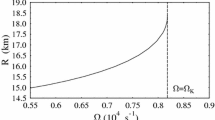Abstract
IF, as is now generally supposed, stars exhibiting spectra containing uniformly widened lines, commonly designated by the suffix n, are in rapid axial rotation, then the following interesting condition is imposed upon the problem of stellar evolution. It arises from the comparatively recent determination1 that a large number of the early F-type stars (as well as B and A stars) have noticeably widened lines, while but few of the later F's and practically no G or later type stars exhibit this characteristic; and that such n stars cluster closely about the absolute magnitude + 2.0, and thus, by virtue of the mass-luminosity relation, about the stellar mass of twice that of the sun.
Similar content being viewed by others
References
Astrophys. J., 82, 338 (1935); 79, 357 (1934); additional material in press.
Astrophys. J., 72, 1 (1930).
Author information
Authors and Affiliations
Rights and permissions
About this article
Cite this article
HYNEK, J. Axial Rotation and Stellar Evolution. Nature 137, 317–318 (1936). https://doi.org/10.1038/137317c0
Issue Date:
DOI: https://doi.org/10.1038/137317c0
- Springer Nature Limited





